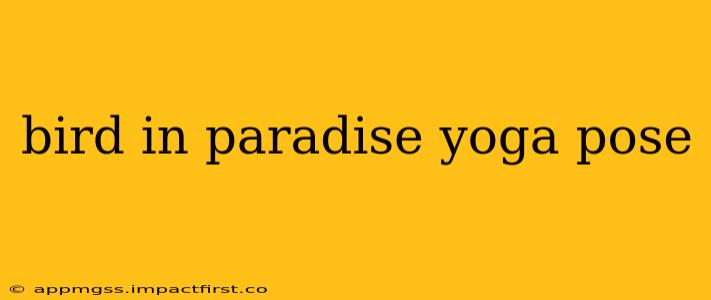The Bird of Paradise pose, or Natarajasana, is a stunning and challenging yoga asana that requires strength, balance, and flexibility. This advanced standing pose is a showstopper, but it's crucial to build up to it gradually to avoid injury. This guide will explore the pose in detail, addressing common questions and providing a step-by-step approach for safe and effective practice.
What Muscles Does Bird of Paradise Yoga Pose Work?
Bird of Paradise deeply engages numerous muscle groups throughout the body. The primary muscles worked include:
- Legs: Quadriceps (thighs), hamstrings (back of thighs), glutes (buttocks), and calf muscles are all heavily engaged for balance and stability.
- Core: Abdominal muscles are crucial for maintaining balance and preventing twisting. A strong core is essential for supporting the backbend.
- Back: Erector spinae muscles (along the spine) are activated to support the backbend, while the latissimus dorsi (lats) are involved in the arm extension and spinal rotation.
- Shoulders and Arms: The shoulders and arms work to support the weight of the body and maintain the overall posture. Deltoids (shoulders), biceps, and triceps all play a role.
By targeting these diverse muscle groups, the Bird of Paradise pose improves strength, flexibility, and overall body awareness.
What are the Benefits of Bird of Paradise Yoga Pose?
The benefits extend beyond physical strength and flexibility:
- Improved Balance and Coordination: This pose significantly challenges your balance, leading to improved proprioception (body awareness) and coordination.
- Increased Flexibility: Regular practice enhances hip, spine, and shoulder flexibility.
- Strength Building: Bird of Paradise strengthens the legs, core, and back muscles.
- Improved Posture: By strengthening the supporting muscles, this asana can contribute to improved posture.
- Stress Relief: The focus and concentration required can help reduce stress and improve mental clarity.
Remember, consistency is key to experiencing these benefits.
How to Do the Bird of Paradise Pose Safely?
Attempting the full Bird of Paradise without proper preparation can lead to injury. Here’s a safe and progressive approach:
- Warm-up: Begin with gentle stretches and warm-up exercises to prepare your muscles for the pose.
- Standing Forward Bend (Uttanasana): This prepares the hamstrings.
- Warrior III (Virabhadrasana III): Develops balance and leg strength. This is a crucial stepping stone to Bird of Paradise.
- Half Bird of Paradise: Practice grasping the ankle with the same-side hand, and gradually increase the depth of the backbend.
- Full Bird of Paradise: Once you feel comfortable with the half pose, slowly try to reach your opposite foot with your hand.
- Modifications: Use a block or chair for support if needed. Focus on maintaining proper alignment and avoiding overstretching.
How Often Should I Practice Bird of Paradise?
Listen to your body. Practicing too frequently when your muscles aren't adequately prepared can lead to injury. Aim for 2-3 times a week, allowing for rest days in between.
Is Bird of Paradise Yoga Pose Suitable for Beginners?
No, the Bird of Paradise pose is considered an advanced yoga pose and isn't suitable for beginners. It requires a strong foundation in balance, strength, and flexibility. Beginners should focus on mastering foundational poses before attempting this challenging asana.
Can I Do Bird of Paradise Yoga Pose Every Day?
It's generally not recommended to practice Bird of Paradise every day. Allow for rest days to prevent muscle strain and injury. Regular practice is beneficial, but moderation is key.
What are Some Modifications for Bird of Paradise Pose?
Several modifications can make this pose more accessible:
- Using a chair: Use a chair for support to help maintain balance.
- Using a block: Place a block under your back foot to make reaching the foot easier.
- Reducing the depth of the backbend: Start with a smaller backbend and gradually increase the depth as your flexibility improves.
Remember to prioritize proper alignment over depth.
By following a gradual, mindful approach and respecting your body's limitations, you can safely and effectively practice the Bird of Paradise pose and reap its numerous benefits. Always consult with a qualified yoga instructor, especially if you have any pre-existing injuries or health concerns.
